Reserve Bank of Australia Annual Report – 1988 Branch Activities and Services
The Bank has offices in each Australian state capital, Canberra, Darwin, London and New York. The Australian offices provide comprehensive banking services to the Bank's customers. They also provide cash distribution and Commonwealth stock registry facilities. Branch staff also maintain contact with financial markets and assist in the supervision of banks. Offices in London and New York play an important role in the Bank's foreign exchange trading in offshore markets and in the investment of foreign currency reserves. They assist in maintaining relationships with other central banks and with international institutions such as the Organisation for Economic Cooperation and Development, the Bank for International Settlements, the International Monetary Fund and the International Bank for Reconstruction and Development. There is a specialist Note Printing Branch at Craigieburn, Victoria.
Banking operations
The Bank is principal banker for the Commonwealth Government, the governments of Queensland, South Australia, Western Australia and Tasmania and a number of statutory authorities. Other customers include banks, authorised dealers in the short-term money market, other central banks and international financial institutions.
The Bank's computer installations now link all Australian branches in a single on-line system. This provides an improved service to customers; in 1987/88 over 60 million customer transactions were processed on a same-day basis.
It was announced in April 1986 that the lending activities of the Rural Credits Department were to be phased out. That process was completed in January 1988 when the last customer loan was repaid. Arrangements are now in train to wind up the Department.
Note printing
Australian banknotes are produced at the Bank's Note Printing Branch at Craigieburn, Victoria. Notes are printed in denominations of $5, $10, $20, $50 and $100. General issue of $2 denomination notes ceased in June, following the issue by the Government of a $2 coin. In January 1988, the Bank began the issue of a special $10 note to commemorate Australia's Bicentenary. Details of this note are given on the following pages.
During 1987/88, the Note Printing Branch produced 389 million pieces of Australian currency notes. The Branch also produced a variety of security documents of a commercial nature, including travellers' cheques.
Through Note Printing Branch, the Bank has been heavily involved in research and development related to aspects of security printing. Much of this has involved collaboration with the Commonwealth Scientific and Industrial Research Organisation and with commercial firms. The $10 Commemorative note contains a number of the fruits of that work. Other recent projects have been concerned with automated inspection systems, machine authentication of notes, special purpose inks and improved engraving processes. Some of these developments have potential for very wide commercial application.
The Commemorative $10 Note
On 27 January 1988, the Bank introduced a new type of $10 note to commemorate Australia's Bicentenary. It is printed on polymer (plastic) instead of paper and includes an optically variable device (OVD), surrounded by a clear area, as a deterrent to counterfeiting. The OVD, which incorporates an image of Captain Cook, diffracts light, producing a varying rainbow pattern when the viewing angle or light source changes. The polymer, which was developed to facilitate inclusion of the OVD, performs comparably to paper in the printing processes. This permits the inclusion of traditional anti-counterfeiting devices based on the note printers' skills.
Development of the note dates from 1968 and has involved close co-operation between the Bank and the Commonwealth Scientific and Industrial Research Organisation. Once the feasibility of a polymer-based note incorporating an OVD had been established, the emphasis shifted to developing the basic technology to enable mass production at the Bank's Note Printing Branch. New inks were developed and production processes were modified to handle the various stages of producing a plastic note.
The Commemorative note was designed by Mr Harry Williamson, the designer of Australia's $100 note, aided by staff at the Bank's Note Printing Branch. The theme of the design is Australian settlement.
One side of the note, part of which is shown on the inside cover of this Report, brings together some elements of Aboriginal culture such as ancient rock paintings, hand stencils, a ceremonial Morning Star Pole and a portrait of an Aboriginal youth wearing body decoration. The note also incorporates work by contemporary Aboriginal artists.
The other side relates to European settlement of Australia over the past 200 years. It shows the ship “Supply” from the First Fleet and a medley of people against a background of Sydney Cove as it appeared in 1788. Illustrations based on this theme, which are reproduced on the cover of this Report, depict the diverse backgrounds from which the Australian nation has evolved.
The new note, while specially prepared to mark the Bicentenary, is also a vehicle for assessment of the new technology. It incorporates many technological advances which offer great promise for future note printing and security printing more generally. Some difficulty with protection of the OVD against abrasion was experienced with the initial issues of the new note. Subsequent work was done to reduce that problem. Special souvenir versions of the note with identifiable numbers and overprinted ‘26 January 1988’ went on sale in early July. A larger volume of general issue Commemorative notes is scheduled for release later in the year.
2 Clear area.
3 & 4 Wave pattern (visible when note is held to the light).
5 Supply.
6 The medley of people.
7 Sydney Cove.
8 Aboriginal boy.
9 Morning Star Pole.
10 Female rock painting.
11 & 12 Complementary diamond-shaped patterns on each side of the note.
13 Microprinting
14 & 15 Serial numbers.
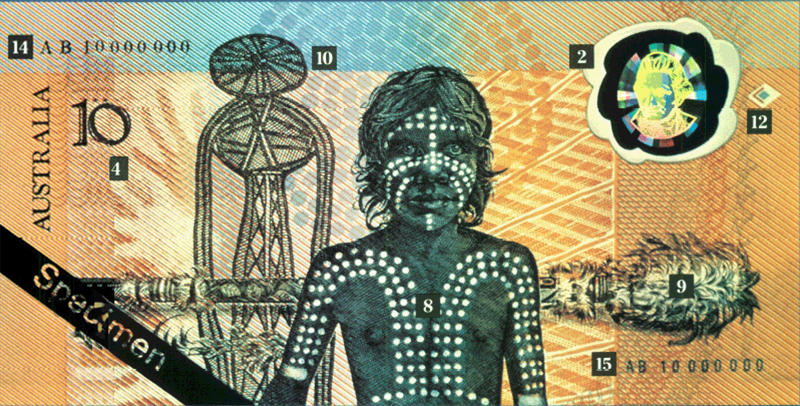
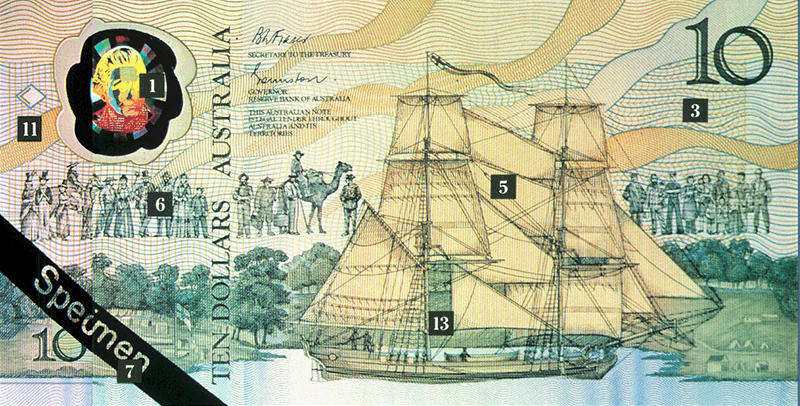
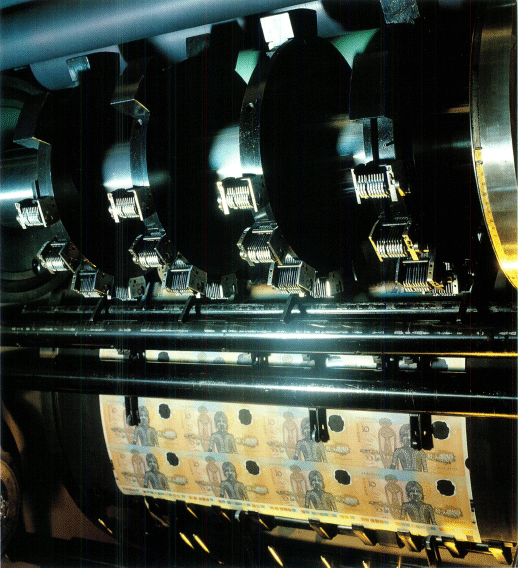
Currency issue and distribution
Currency is issued through the Bank's branch network mainly to other banks. Notes and coin surplus to banks' requirements are retur ned to the Bank for reissue. Notes which are no longer fit for issue are destroyed.
During the year ended 30 June 1988, the Bank issued $36.1 billion in notes and $34.7 billion was returned by banks; this compared with $32.1 billion and $31.2 billion respectively in 1986/87. Most notes returned to the Bank's branches are processed through high speed currency verification, counting and sorting (CVCS) machines. These machines automatically identify and withdraw notes no longer suitable for circulation and thus help maintain the quality of notes on issue. The CVCS machines also assist with the detection of counterfeit notes.
The value of notes on issue totalled $11,364 million at end June 1988, some $1,622 million higher than a year earlier. Further details are provided in the following table.
| At end June | $1 | $2 | $5 | $10 | $20 | $50 | $100 | Total |
|---|---|---|---|---|---|---|---|---|
| 1984 | 57 | 170 | 184 | 514 | 2,250 | 3,453 | 609 | 7,237 |
| 1985 | 45 | 179 | 194 | 522 | 2,312 | 3,430 | 1,552 | 8,234 |
| 1986 | 42 | 174 | 204 | 525 | 2,282 | 3,442 | 2,246 | 8,915 |
| 1987 | 40 | 173 | 213 | 525 | 2,274 | 3,539 | 2,978 | 9,742 |
| 1988 | 38 | 154 | 228 | 576 | 2,516 | 3,911 | 3,941 | 11,364 |
The Bank distributes coin produced by the Royal Australian Mint. The armoured car companies in the various states now play a large part in the handling, transportation and storage of coin.
Over the year ended 30 June 1988, coin to the value of $683 million was put into circulation and about $573 million was returned by banks and other users. It is estimated that $73 million of the new $2 coin was in circulation by the end of June.
During the year the Bank returned excess stocks of coin valued at $50 million to the Mint.
20 Value of Notes on Issue
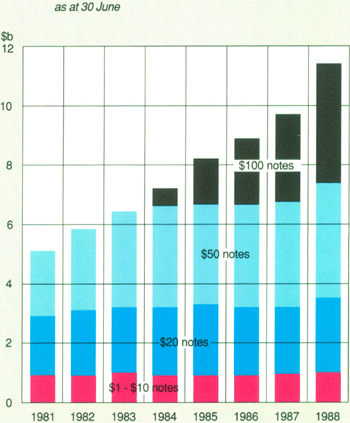
Government securities
The Bank performs a number of roles related to the issue and marketing of Commonwealth Government securities. It advises the Commonwealth Government on aspects of debt management; conducts tenders for the issue of bonds and Treasury notes; handles interest payments and redemptions; and operates stock registries at its State capital city Australian branches, Canberra and Darwin. In its monetary policy operations, the Bank, of course, is also a major participant in the secondary bond and Treasury note markets. Operations in these markets are described in the chapter entitled “Financial Markets and the Bank's Operations”. Commonwealth Government securities on issue at all Australian registries fell by $2.2 billion in 1987/88 to $49 billion; this mainly reflected the budget surplus in the year.
During the year, the Bank further improved the services available at its Inscribed Stock Registries. A new computer system was installed which allows transactions to be passed to stockholders' accounts without delay and thus provide up-to-date information about transactions and balances. The system should be fully operational in all Registries early in 1988/89. The Bank is also looking at ways to improve settlement procedures in the secondary market for Commonwealth Government securities. This is likely to be provided through an on-line computerised system, linked to existing private sector facilities.
In January 1988, the Government announced suspension of further issues of Australian Savings Bonds, which were first offered for sale in 1976. The latest issue, Series 29, was withdrawn from sale in September 1987. The decision followed indications that the Budget would be in surplus in 1987/88. Net issues of Australian Savings Bonds had been declining; redemptions had substantially exceeded purchases in the previous three years. For some years, the Bank has provided a facility to permit the sale of bonds by small investors at market prices. During the past year, this was complemented by a service through which investors may buy, from the Bank, parcels of selected series of Treasury bonds at market-related prices. There is a maximum daily limit of $50,000 (face value) and a charge of 25 cents per $100 face value. The Bank also provides a facility which allows any holder of Treasury notes due to mature within 90 days to sell them to the Bank at a discount on face value.
Services
During recent years, the Bank has sought to improve its communication with markets and with the public. It has widened the range of information issued on monetary matters and tried to explain better the Bank's role and policies. It is hoped that further improvements will follow the establishment of two special offices in the Bank, one concerned with Media and Information, the other with Community Relations:
• Media and information
The Media and Information Office handles enquiries from the press and the public. It is also responsible for distribution of the Bank's various publications.
The Bank's publications can be obtained at any of its branches. They include the Bank's press releases on topical subjects as well as the regular monthly Reserve Bank Bulletin which contains a wide variety of economic and financial statistics and commentary on monetary policy and financial matters more generally. Also available are booklets dealing with the functions and operations of the Bank.
• Community relations
The Bank recognises the need to keep the community informed on important monetary issues. As is usual, the Governor, Deputy Governor and senior officers spoke to a wide variety of professional and other groups during the year.

The Bank is happy to supply speakers or background material on appropriate topics to community groups, professional associations, secondary and tertiary students and teachers; school and other groups are also welcome to visit the Bank's branches.
The Bank's participation in Bicentenary activities took a number of forms. It initiated a series of biographical essays on Australian financiers during the past two centuries. Professors R.T. Appleyard and C.B. Schedvin were commissioned to edit the series, which has recently been published commercially under the title Australian Financiers — Biographical Essays. The biographies range from the Colonial Commissaries and founders of Australia's early banks to notable financiers of more recent times. Many were influential in the establishment and financing of Australia's major industries; others contributed to the evolution of economic policy making. The Bank is also sponsoring, through its Economic and Financial Research Fund, a collection of Australian economic and financial documents of importance in the 1900s. The work is being done by Dr G. Manger of the Australian Defence Force Academy. It is likely to be of interest to a rather specialised group but is a valuable contribution to Australia's financial history. Limited publication is expected before the end of 1988.
Displays featuring the Commemorative $10 note are being mounted in all branches during 1988. The Bank also provided displays based on the $100 note for the Bicentennial Travelling Exhibition and material for a convention held by the Coin Fair and the Numismatic Association of Australia in Sydney.
Organised groups have been welcome to visit, by arrangement, the Bank's Note Printing Branch at Craigieburn in Victoria. This facility will be expanded later in 1988 when a display centre is opened at the Branch. Visitors will be able to see Australian notes being printed and displays of earlier printing techniques, machinery and historical collections.
Relations with other central banks
The Bank maintains close contacts with central banks and monetary authorities in other countries. This has become increasingly important in recent years given the greater integration of financial markets and the global operations of banks, including Australian banks, and other financial institutions.
Of particular relevance to Australia, of course, are the South East Asian and Pacific Rim countries. The Bank hosted the 17th meeting of the SEANZA Council of Governors of Central Banks in October 1987. The meeting brought together Governors, or their deputies, of 16 central banks from the region. The third meeting of the SEANZA Forum of Banking Supervisors was also hosted by the Bank in Sydney in March 1988. The 17th SEANZA Central Banking Course will be conducted later in 1988 at the Bank's residential centre in Sydney. The course will bring together students and directing staff from 22 central banks, primarily from the Pacific area. Specialist lecturers will be drawn mainly from central banks and universities in Asia, Europe and North America.
In November 1987, the third annual meeting of Governors of South Pacific Central Banks was held at the Bank's Head Office. The meeting was organised in conjunction with the Institute for Development Studies at the Australian National University, to discuss economic and banking issues in the region.
The Bank is a shareholder in the Bank for International Settlements and the Governor or Deputy Governor attend the regular meetings with Governors of other member central banks. In the banking supervision area there has been close liaison with the Basle Supervisors' Committee which meets under the auspices of the Bank for International Settlements. Bank staff were also members of Australian delegations to meetings of the International Monetary Fund and the International Bank for Reconstruction and Development, the Asian Development Bank and the Organisation for Economic Co-operation and Development.
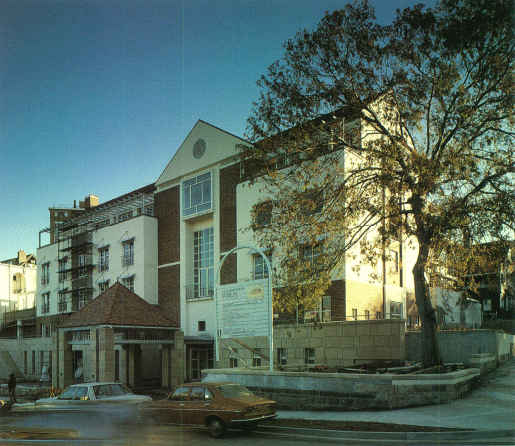
Research
As well as undertaking its own research into matters of direct interest to it, the Bank supports outside research, primarily in universities, through its Economic and Financial Research Fund. In 1987/88, grants were made to support projects which included several conferences and an economic history of Australia.
The Bank also for many years has made grants from the Rural Credits Development Fund for a wide range of research projects for the promotion of primary production. Funds have been provided from the net profits of Rural Credits Department in terms of the Reserve Bank Act. The timetable for phasing out the Rural Credits Department now means that final grants from the Fund will be made out of the 1987/88 profits of the Rural Credits Department and will be awarded during the second half of 1988. That will bring aggregate awards since 1945 to around $40 million.
Freedom of Information
Twenty three requests for access to documents under the Freedom of Information Act were received during the year, compared with twenty one in 1986/87. All but three of the requests in 1987/88 were from staff or former staff.
Twenty of the requests were granted in full, one remains to be completed. Two were refused on the grounds that the documents were exempt. In one case, access was granted to some documents on review. Two requests were received from other agencies and were returned to those agencies.
The cost to the Bank of administering the Act in 1987/88, including staff and overheads, is estimated to have been approximately $9,800.